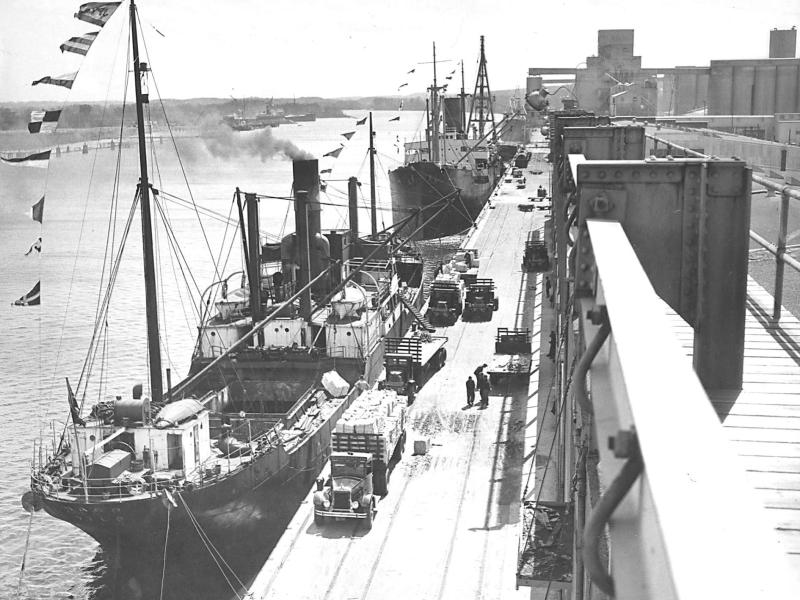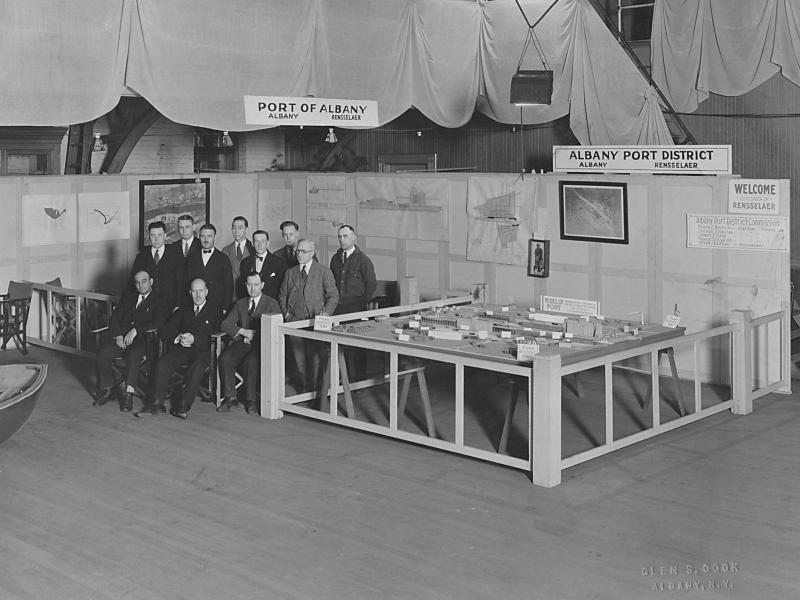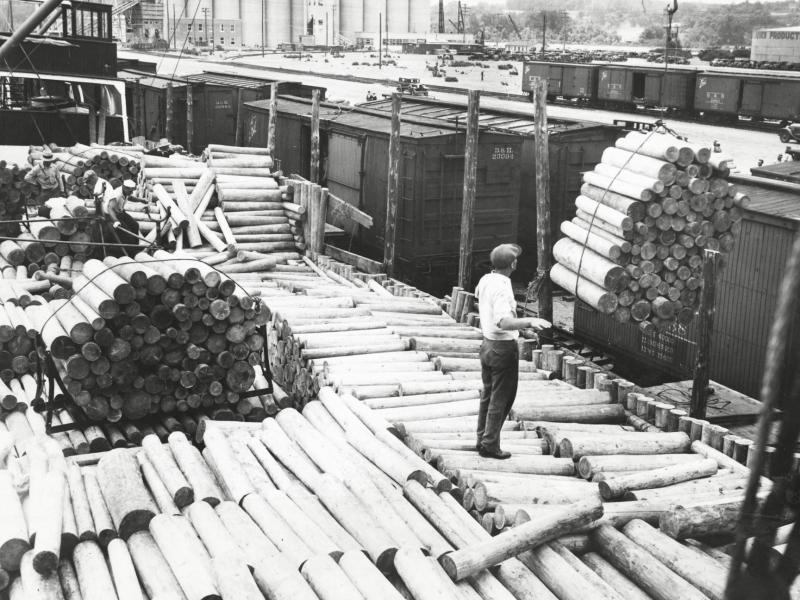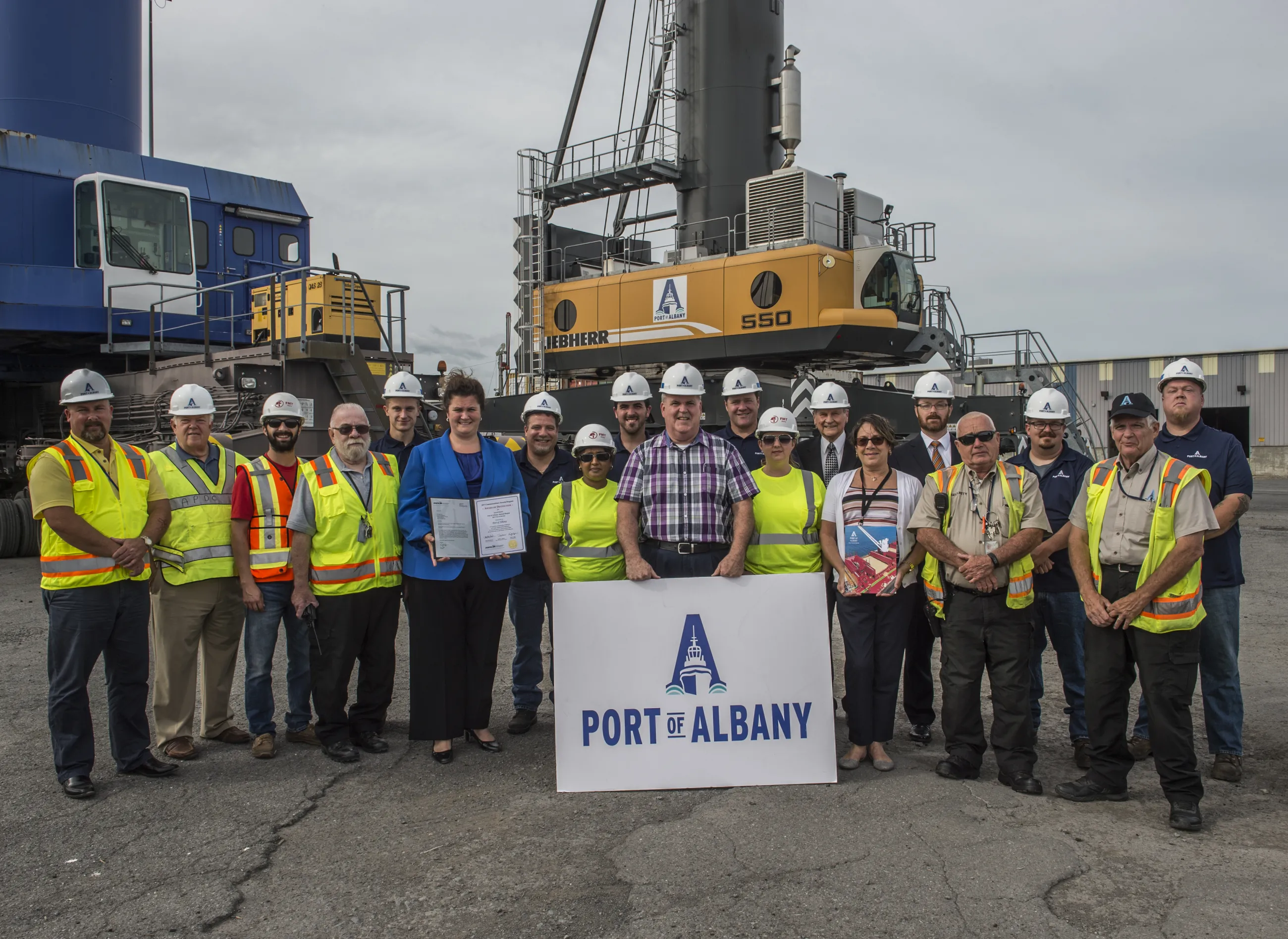History
The City of Albany, New York began serving as a port as early as the 17th century when, in 1614, the Dutch first set up a trading post near the South End. In 1624, the Dutch built Fort Orange where goods such as rum, sugar and lumber were brought over from Europe and the West Indies. As trade increased, so did settlement. The population grew to include not only farmers and fur traders, but merchants and entrepreneurs engaged in the transport of goods and other activities. Ferry service began in 1642, developing the area for commerce on both sides of the Hudson River.
On this page:

At the time of this photo (1932), the Port of Albany could boast of having the largest single unit grain elevator in the world at Cargill, Inc. and until 2008, was still considered to be the largest in the United States east of the Mississippi River
After the British conquest in 1664, trade continued to flourish, including the fur trade. In 1686, the Dongan Charter established Albany as a separate municipal entity, helping to cement the City’s identity as an urban center of commercial activity.
In 1766, to accommodate more ship traffic, the Albany Common Council provided funding for the construction of three stone docks. In 1825, a 4,000-foot-long and 80-foot-wide pier was built, located approximately 250 feet from Albany’s shoreline where the Erie Canal and Hudson River met. Known as the Albany Basin, it provided moorings for many sloops, steamboats and canal boats.

Looking south on the Hudson River, ships alongside the Port of Albany transit sheds unload cargo (1932)

The Port of Albany officially opened in 1932. Dedication ceremonies involved much fanfare including opening remarks from New York Governor Franklin D. Roosevelt, a parade, and the "Wedding of the Waters," when the waters of one hundred American and foreign ports were mingled with those of the Hudson River, symbolizing the new meeting point of water-borne trade at the tidewater head of the Hudson. Then-Gov. Roosevelt's speech, to a crowd estimated at 25,000, was carried live nationwide by NBC and CBS radio. (Courtesy of Albany County Hall of Records Archival Collection)
The Albany Basin contained an area of 32 acres with a pier stretching from Lawrence Street (near the Erie Canal entrance) to Hamilton Street. In addition to the basin, nearby private slips and wharves were erected and in 1870, construction began on the Maiden Lane Bridge, a railroad bridge that would connect Albany to Rensselaer. Traffic on the Hudson River would increase exponentially after the Albany Basin and Erie Canal were built in 1825.
Many historically significant ships used Albany as their home port. The Experiment left Albany in 1785 to become the second American ship to sail to China. In 1809, Robert Fulton’s Clermont became the first commercially viable steamboat when it left Albany and sailed down the Hudson to the city of New York.
In 1915, a survey looking into the possibility of deepening the Hudson River was proposed to Congress. By 1924, plans to dredge a deep channel were approved. In 1927, work on the dredging of a 30-mile-long, 27-feet-deep channel up the Hudson River, began. The project was completed in June 1931.
In 1925, New York Governor Al Smith created the Albany Port District Commission (APDC) which directed the construction of the port.
Port construction was rapid, with construction completed in less than two years. Albany and Rensselaer spent $10 million transforming hundreds of acres of land into docksides, building wharves, and sheds on both sides of the Hudson River. The entire landsite was raised nearly 18 feet to accommodate major ocean freighters to load and discharge cargoes from around the world. During this time the largest single unit grain elevator in the world, the Cargill Grain Elevator was built at the Port of Albany with silos that were 100 feet high!
On June 6 and 7, 1932, the Port of Albany officially opened. Dedication ceremonies involved much fanfare including opening remarks from New York Governor Franklin D. Roosevelt, a great parade, and the "Wedding of the Waters." The waters of one hundred American and foreign ports were mingled with those of the Hudson River, symbolizing the new meeting point of water– borne trade at the tidewater head of the Hudson.
At the time it was built, the Port of Albany connected shipping from the Hudson River to six main railroad lines, a 14,000-mile highway system, and to the 525-mile New York State Barge Canal – The “Gateway to the World” was the signature theme for the 1932 opening ceremonies.

Pulp wood from Canada and Europe was discharged directly from ships to rail cars (1935)
In the early years of the Port, much of the business conducted centered on the importing of wood products (e.g. wood pulp) and automobiles, and the export of various paper products. When the United States entered World War II in 1941, the Port served primarily as a military supply depot. After the war ended, normal port activities resumed and in 1952, the Hudson River was dredged for a second time, to 32 feet deep, allowing for larger ships to make their way through.
Though wood and grain dominated operations at the Port in its earlier years, the importing and exporting of automobiles, fruit and other cargo grew. The D&H and New York Central Railroads laid 25 miles of track to develop the Port. By 1935, six major railroads converged at the Port of Albany which had miles of track of its own.
In 2011, 800 feet of wooden wharf on the Albany side was rehabbed and a new rail line was built, allowing cargo to be directly transported between ship and train. In October 2014, the Rensselaer Wharf reconstruction project was completed. In 2018, the Port acquired an additional 80 acres in the Town of Bethlehem which increased the Port to more than 450 acres, on both sides of the Hudson River and in four municipalities.
Today, close to two dozen tenants call the Port of Albany home representing industries such as agriculture, construction, and recycling, bulk commodities such as grain, forest products, molasses, scrap iron, and steel are handled, and specialized services such as heavy/oversized capacity of wind energy products and multimodal connections serve customers around the globe.
Enabling Legislation
